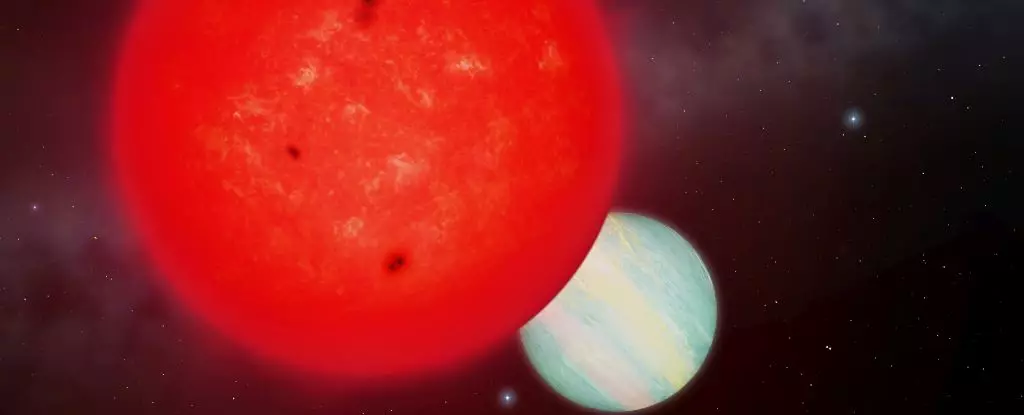In the grand tapestry of our universe, the discovery of TOI-6894b stands out like a jewel against a dark backdrop. This exoplanet orbits TOI-6894, a diminutive red dwarf star with only a fifth of our Sun’s mass, defying the long-held belief that small stars are incapable of birthing giant planets. At 86 percent the size of Jupiter, TOI-6894b proves to be an imposing presence, yet its home star challenges our understanding of stellar and planetary formation processes. This remarkable finding has ignited fervor within the astrophysical community, unraveling a mystery that fundamentally reshapes our understanding of how planets can form in the cosmos.
Exploring the Formation of Stars and Planets
To grasp the significance of this discovery, one must first explore how stars and planets form. The prevailing theory suggests that stars materialize from clouds of gas and dust, collapsing under gravity’s pull until a protostar forms. This protostar is surrounded by a rotating disk of leftover material, gradually coalescing into planets. The conventional wisdom indicates that a star’s mass largely determines the mass of the surrounding material; hence, it was presumed that low-mass stars like TOI-6894 would lack the necessary resources to create gas giants. However, TOI-6894b throws a wrench into this established narrative, suggesting that nature has more surprises in store for us.
Scientific Revelations and Groundbreaking Techniques
Astrophysicist Edward Bryant and his international team have spearheaded this exciting journey into the unknown. Beginning with an impressive examination of TESS data across 91,000 red dwarf stars, Bryant focused their efforts on TOI-6894 after detecting its unusual light patterns. What was particularly thrilling was the discovery of a staggering 17 percent light dip during the planet’s transit, which made it an excellent candidate for further study. This unique characteristic provided astronomers with vital clues about both the star and its illustrious planet.
The transit method of detection, where dimming light indicates the presence of an exoplanet, typically yields inconspicuous signs. Yet TOI-6894’s pronounced dimming offered an unparalleled opportunity to analyze its compelling gravity and ascertain the size and mass of TOI-6894b—making it an extraordinary subject for ongoing study.
Unlocking Atmospheric Mysteries
One of the most exhilarating implications of this discovery is the potential to probe TOI-6894b’s atmosphere. The research team’s insights suggest that during transits, light from the parent star passes through the exoplanet’s atmospheric layers, allowing scientists to inspect the elements that comprise this alien world. The anticipation surrounding what could be discerned through upcoming observations with advanced instruments like the James Webb Space Telescope further heightens the excitement in the scientific community. With exoplanetary temperatures expected to reveal methane and other compounds, TOI-6894b may become a pivotal player in our understanding of atmospheric compositions in exoplanetary systems.
The Challenge to Existing Theories
The existence of TOI-6894b poses a profound challenge to our current models of planet formation. Traditionally, scientists have leaned towards two primary theories to explain the genesis of gas giants: a gradual accumulation of material or the direct collapse of elements in a protoplanetary disk. However, the conundrum posed by TOI-6894b indicates that neither hypothesis can explain the formation of such a massive planet around a star of minimal mass. This revelation not only fosters a renewed interest in the mechanisms of planet formation but also highlights the limitations of our existing frameworks.
Astrophysicists like Vincent Van Eylen articulate the intrigue surrounding TOI-6894b, emphasizing a shared desire within the community to unravel the mysteries of its formation. As researchers delve deeper into the atmospheric composition and the gravitational interactions between TOI-6894b and its parent star, we stand on the brink of monumental breakthroughs that could redefine our understanding of planetary systems.
The discovery of TOI-6894b heralds a new chapter in the saga of exoplanet research. It underscores the necessity for an open mind in scientific inquiry, demonstrating that assumptions about stellar systems can be upended in the face of new evidence. Over the coming years, scientists will undoubtedly continue to explore TOI-6894b and its parent star, unraveling threads of knowledge that strengthen our understanding of the cosmos. With each revelation, we inch closer to describing the legacy of stars and planets born from the very fabric of space—a narrative that is as rich and complex as the universe itself.


Leave a Reply